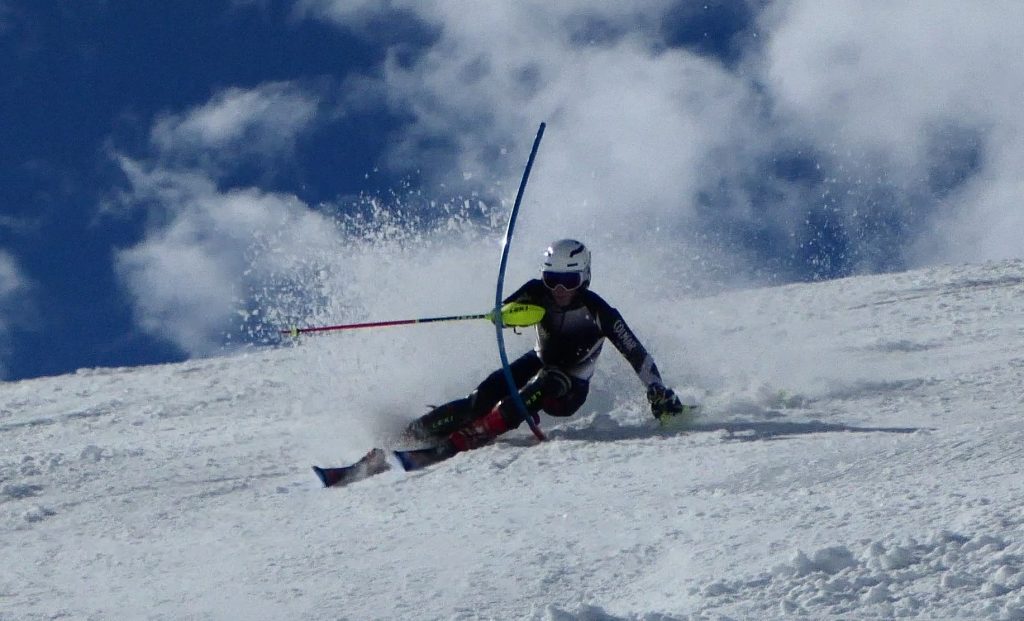Toby skied 50 metres down the hill to show me how he skied… very unstable – ski tails being pushed outward, weight on the backs of the skis, weight perched precariously over the outside ski and obviously not enjoying the outcome of all of this. 100% predictable and 100% not his fault.
Toby turns out to have excellent aptitudes and could accurately do everything he was asked to do almost immediately – and retain it. That’s extremely rare! If he ever wants to try ski racing – please let me coach him!
Dynamics (Second and third video clips)
The lifts were 10 minutes late in opening so I used it to introduce our key subject – “Dynamics”! Fortunately Toby is studying physics at school and is interested so he was prepared to listen.
The term “balance” as used in skiing is a complete fallacy. I’m not going to repeat the lesson here but instead link to an overview that covers the actual lesson given on the subject…
http://madeinmountains.com/dynamics/
Toby was able to do the dynamics exercises well partly because he easily responded to “coming forward” into the perpendicular to the slope when asked to do so. This permits the front of the ski to work – and like a car or a bicycle that’s where the turning power is found.
We covered dynamics use to accelerate the centre of mass into the turn – to then maintain the acceleration (angular) during the turn development and then using the build up of pressure at the end of the turn to lift the centre of mass out of the turn.
Just remember – push with the uphill leg to drive that centre of mass – and hold the leg strong for the whole turn. Move the centre of mass – not the ski! It does not matter what edge the uphill ski is on during the push! The leg will extend – but the centre of mass comes down toward the snow – like a motorbike in a turn.
Dynamics with free motion of the centre of mass is for racing and strong off piste skiing. The uphill ski is rapidly on its inside edge and accelerating. Ride the ski from the start of the turn and this gives you grip and control.
Angulation (Third video clip)
One legacy from Toby’s previous skiing was a strong body rotation from trying to force the skis around instead of using them as a turning tool. The solution to this and to having improved pressure on the ski fronts is “hip angulation”!
In a nutshell, during the second half of the turn – especially if it’s a short turn – the outside hip joint needs to be pulled backward – so the pelvis ends up facing more or less downhill. This creates a slight stretch between the bottom front rib and the pelvis – then the postural reflexes can function to protect the lower back. We did a static exercise so that Toby could feel this reflex. What you must NEVER do is try to face downhill with the chest or shoulders – this destroys the lower back.
http://madeinmountains.com/chiskiing/

Pivot (First video clip)
Toby is one of very few skiers who managed to do a reasonable job of pivoting right from the first few attempts. The full progression of “Pivot” is found here…
http://madeinmountains.com/pivo/
Pivoted turns are braking turns – the skis are always on uphill edges and never travelling across the hill. This is how to ski fully controlled in a narrow lane on on narrow steeps. Pivoting works well on bumps (it’s what forms bumps in the first place) – the tips and tails can be in mid air as the skis pivot.
The pole is used firmly in pivoting – it has to be used to restrain the movement of the centre of mass. This is what a ski pole is for! Always move the centre of mass inward toward the pole until the turn is over. Hip angulation needs to be present to link turns and prevent excessive body rotation.
We practised side slipping on a steep icy slope – using the centre of mass as a “joy stick” to control the slip – including forward and backward diagonal slipping.
Most turns – even with free dynamics – begin with the uphill ski on its outside edge and a sort section of pivoting – this being why skiers keep their feet close together. It’s easier than pushing a ski out into a stem to get on its inside edge and it drives the centre of mass correctly into the next turn.



